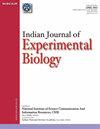Ameliorating effects of crude fucoidan extracts from Sargassum spp. obtained from Penghu Islands, Taiwan
IF 0.7
4区 生物学
Q4 BIOLOGY
引用次数: 0
Abstract
The predominant species of seaweed in Taiwan's coastal waters is Sargassum species, which exhibits a broad spectrum of bioactivities. Methods: Four Sargassum species (S. crassifolium, S. siliquosum, S. hemiphyllum, and S. hemiphyllum var. chinense) were used to produce eight fucoidan extracts, namely SC, SCH, SS, SSH, SH, SHH, SHC, and SHCH. These extracts were produced with or without a compressional puffing pretreatment. The compressional-puffing process increased the extraction yield of fucoidan and decreased levels of impurities (proteins and polyphenols). Among the eight fucoidans, SS (IC50 DPPH 0.46±0.01 mg/mL; IC50 ABTS•+ 0.09±0.00 mg/mL; FRAP value 67.4±0.9 μmol/g extract, vitamin C equivalent) and SHC (IC50 DPPH 0.53±0.17 mg/mL; IC50 ABTS•+ 0.11±0.00 mg/mL; FRAP value 55.1±0.6 μmol/g extract, vitamin C equivalent) displayed the highest antioxidant activity; SS (36.4±10.1% at 5 mg/mL for alpha-amylase; 96.3±0.2% at 1 mg/mL for alpha-glucosidase) and SHC (35.0±2.2% at 5 mg/mL for alpha-amylase; 96.5±0.2% at 1 mg/mL for alpha-glucosidase) showed the strongest alpha-amylase and alpha-glucosidase inhibitory activities; SH, SHH, and SHC had the most potent anti-inflammatory activity; and SHH had a greatest protective effect against damage to pancreatic cells. Hence, SS, SH, SHH, and SHC may be effective health-promoting agents for nutraceutical products.台湾澎湖马尾藻褐藻聚糖粗提物的改良作用
台湾近岸海藻的优势种是马尾藻,具有广泛的生物活性。方法:以四种马尾藻(S. crassifolium, S. siliquosum, S. hemiphyllum, S. hemiphyllum var. chinense)为原料,制备SC、SCH、SS、SSH、SH、SHH、SHC、SHCH八种岩藻多糖提取物。这些提取物有或没有压缩膨化预处理。压缩膨化工艺提高了岩藻聚糖的提取率,降低了杂质(蛋白质和多酚)的含量。8种岩藻多糖中,SS (IC50 DPPH 0.46±0.01 mg/mL;IC50 ABTS•+ 0.09±0.00 mg/mL;FRAP值67.4±0.9 μmol/g提取物,相当于维生素C)和SHC (IC50 DPPH 0.53±0.17 mg/mL;IC50 ABTS•+ 0.11±0.00 mg/mL;FRAP值为55.1±0.6 μmol/g,相当于维生素C),抗氧化活性最高;α -淀粉酶(36.4±10.1%,5 mg/mL);α -葡萄糖苷酶在1 mg/mL时为96.3±0.2%),α -淀粉酶在5 mg/mL时为35.0±2.2%;α -葡萄糖苷酶(96.5±0.2%,1 mg/mL)对α -淀粉酶和α -葡萄糖苷酶抑制活性最强;SH、SHH和SHC具有最强的抗炎活性;SHH对胰腺细胞的损伤有最大的保护作用。因此,SS、SH、SHH和SHC可能是营养保健品中有效的健康促进剂。
本文章由计算机程序翻译,如有差异,请以英文原文为准。
求助全文
约1分钟内获得全文
求助全文
来源期刊
CiteScore
1.57
自引率
33.30%
发文量
84
审稿时长
6 months
期刊介绍:
This journal, started in 1963, publishes full papers, notes and reviews in cell biology, molecular biology, genetic engineering, endocrinology, reproductive biology, immunology, developmental biology, comparative physiology, radiation biology, chronobiology, microbiology, pharmacology, toxicology and other biological fields including instrumentation and methodology. The papers having experimental design involving alteration and/or manipulation in biological system(s) providing insight into their functioning are considered for publication. Studies involving higher animals, human beings and of clinical nature are not encouraged for publication in the journal.

 求助内容:
求助内容: 应助结果提醒方式:
应助结果提醒方式:


